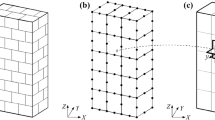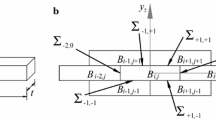Abstract
A description of brick/block masonry by continua equivalent to discrete systems made of blocks of different geometry and texture is proposed in this paper. Here, the reasons for the selection of a micropolar continuum with respect to the classical continuum are discussed. As recent research in various micromorphic multifield formulations shows, the problem of the choice of the most appropriate continuum to model masonry mechanical behavior is still open, and the advantages of non-classical continuum modeling are not yet completely ascertained. Earlier analyses performed on masonry panels in the presence of load and geometrical singularities pointed out the significant role of the additional degree of freedom of the micropolar continuum (microrotation) and of its gradient. The present study aims to expand the investigation into the consequences of changes in blocks’ shape, size and arrangement on the response of block masonry panels under shear forces. This analysis points out the greater effectiveness of micropolar models in capturing the gross structural response of masonry, with respect to the classical modeling. The cases analyzed herein show that apart from the very peculiar case of orthotetragonal symmetry, not only the gradient of microrotation but also the relative rotation between the local rigid rotation and the microrotation, to which relevant non-symmetric strains correspond, are predominant in the majority of the performed numerical tests. Models lacking in these strain measures are therefore inappropriate. The results obtained, ascertained by analyses performed on discrete block assemblies, point out that the micropolar continuum provides a proper description of the masonry behavior. Moreover, the differences between micropolar and classical models remain when the internal lengths vanish.
Similar content being viewed by others
References
Nappi A., Tin-Loi F.: A numerical model for masonry implemented in the framework of a discrete formulation. Struct. Eng. Mech. 11(2), 171–184 (2001)
Baggio, C., Trovalusci, P.: Stone assemblies under in-plane actions. Comparison between nonlinear discrete approaches. In: Middleton, J., Pande, G.N. (eds.) Computer Methods in Structural Masonry-3, pp. 184–193. BIJ, Swansea (1995)
Camborde F., Mariotti C., Donzè C.: Numerical study of rock and concrete behaviour by discrete element modelling. Comput. Geotech. 27, 225–247 (2000)
Baggio C., Trovalusci P.: Collapse behaviour of three-dimensional brick-block systems using non linear programming. Struct. Eng. Mech. 10(2), 181–195 (2000)
Sanchez-Palencia, E., Zaoui, A. (eds.): Homogenization Techniques for Composite Media. Springer, Berlin (1987)
Anthoine A.: Derivation of the in-plane elastic characteristics of masonry through homogenization theory. Int. J. Solids Struct. 32(2), 137–163 (1995)
Lourenço P.B.: Computational Strategies for Masonry Structures. Ph.D. Thesis. Delft University of Technology, The Netherlands (1996)
Forest S., Sab K.: Cosserat overall modeling of heterogeneous materials. Mech. Res. Commun. 25, 449–454 (1998)
Ostoja-Starzewski M., Boccara S.D., Jasiuk I.: Couple-stress moduli and characteristic length of a two-phase composite. Mech. Res. Commun. 26(4), 387–396 (1999)
Forest S., Dendievel R., Canova G.R.: Estimating the overall properties of heterogeneous Cosserat materials. Model. Simul. Mater. Sci. Eng. 7, 829–840 (1999)
Trovalusci P., Masiani R.: Non-linear micropolar and classical continua for anisotropic discontinuous materials. Int. J. Solids Struct. 40, 1281–1297 (2003)
Trovalusci P., Masiani R.: A multi-field model for blocky materials based on multiscale description. Int. J. Solids Struct. 42, 5778–5794 (2005)
Besdo D.: Towards a Cosserat-theory describing motion of an originally rectangular structure of blocks. Arch. Appl. Mech. 80, 25–45 (2010)
Stefanou I., Sulem J., Vardoulakis I.: Homogenization of interlocking masonry structures using a generalized differential expansion technique. Int. J. Solids Struct. 47, 1522–1536 (2010)
De Bellis, M.L., Addessi, D.: A Cosserat based multiscale model for masonry structures. In: Trovalusci, P., Ostoja-Starzewski M. (eds.) Multiscale Mechanical Modelling of Complex Materials. Int. J. Multiscale Comput. Eng. 9(5), 543–563 (2011)
Bacigalupo, A., Gambarotta, L.: Non-local computational homogenization of periodic masonry. In: Trovalusci, P., Ostoja-Starzewski M. (eds.) Multiscale mechanical Modelling of Complex Materials. Int. J. Multiscale Comput. Eng. 9(5), 565–578 (2011)
Sluys L., de Borst R., Mhlhaus H.-B.: Wave propagation, localization and dispersion in a gradient-dependent medium. Int. J. Solids Struct. 30(9), 1153–1171 (1993)
Capriz G.: Continua with Microstructure. Springer, Berlin (1989)
Eringen A.C.: Microcontinuum Field Theories. Springer, New York (1999)
Capriz G., Podio-Guidugli P.: Whence the boundary conditions in modern continuum physics?. Atti dei Convegni Lincei 210, 19–42 (2004)
Forest S., Trinh D.K.: Generalised continua and the mechanics of heterogeneous materials. Z. angew. Math. Mech. 91, 90–109 (2011)
Trovalusci P., Capecchi D., Ruta G.: Genesis of the multiscale approach for materials with microstructure. Arch. Appl. Mech. (Ingenieur-Archiv) 79, 981–997 (2009)
Capecchi D., Ruta G., Trovalusci P.: From classical to Voigt’s molecular models in elasticity. Arch. Hist. Exact Sci. 64, 525–559 (2010)
Capecchi D., Ruta G., Trovalusci P.: Voigt and Poincaré’s mechanistic-energetic approaches to linear elasticity and suggestions for multiscale modelling. Arch. Appl. Mech. (Ingenieur-Archiv) 81(11), 1573–1584 (2011). doi:10.1007/S00419-010-0502-Z
Ortiz M., Phillips R.: Nanomechanics of defect in solids. In: Van der Giessen, E., Wu, T. (eds.) Advances in Applied Mechanics, vol. 36, pp. 1–73. Academic Press, San Diego (1999)
Palla P., Ippolito M., Giordano S., Mattoni A., Colombo L.: Atomistic approach to nanomechanics: concepts, methods, and (some) applications. In: Pugno, N. (ed.) The Nanomechanics in Italy, pp. 75–103. Transworld Research Network, Kerala (2007)
Trovalusci P., Masiani R.: Material symmetries of micropolar continua equivalent to lattices. Int. J. Solids Struct. 36(14), 2091–2108 (1999)
Muki R., Sternberg E.: The influence of couple-stress concentrations in elastic solids. Zeitschrift für angewandte Mathematik und Physik 16, 611–648 (1965)
Sternberg E., Muki R.: The effect of couple-stresses on the stress concentration around a crack. Int. J. Solids Struct. 3, 69–95 (1967)
Sokolowski M.: The Theory of Couple-Stresses in Bodies with Constrained Rotations. CISM, Udine (1972)
Podio-Guidugli P., Vianello V.: The representation problem of constrained linear elasticity. J. Elast. 28, 271–276 (1992)
Author information
Authors and Affiliations
Corresponding author
Rights and permissions
About this article
Cite this article
Pau, A., Trovalusci, P. Block masonry as equivalent micropolar continua: the role of relative rotations. Acta Mech 223, 1455–1471 (2012). https://doi.org/10.1007/s00707-012-0662-8
Received:
Revised:
Published:
Issue Date:
DOI: https://doi.org/10.1007/s00707-012-0662-8




